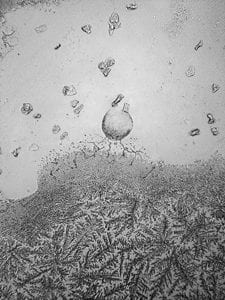
What is PTSD?
Post-traumatic stress disorder (PTSD) is a mental disorder that occurs after experiencing or witnessing a traumatic event. The main symptom of PTSD is persistent re-experiencing of the original event. Many people experience intense recurring thoughts and feelings related to the trauma, or even flashbacks and nightmares. Symptoms of PTSD can also include sadness, fear, anger, and emotional detachment. There are various effective treatment options for PTSD, including cognitive behavioral therapy (CBT), exposure therapy and drug-based approaches. Recent research indicates that MDMA-assisted psychotherapy can be effective in the treatment of PTSD's root causes. This article provides a brief introduction to PTSD. If you recognize the symptoms described below and would like to speak to someone, please click on the link below to make an appointment.

What are the symptoms of PTSD?
Symptoms of PTSD can be divided into four categories: Intrusive memories, avoidant behaviour, negative changes in thoughts and mood, changes in emotional and physical reactions.
Intrusive memories
For those with PTSD, traumatic experiences are so intense that they are difficult to move on from. Long after the traumatic moment has passed, vivid and unwanted memories of the experience may persist. Sometimes these memories take the form of thoughts or feelings. In other cases, they take the form of overwhelming flashbacks or terrifying nightmares. These intrusions evoke strong emotional reactions and can make it feel as if the trauma is still happening.
Avoidance
The second category of PTSD symptoms concerns avoidant behavior. For someone with PTSD, certain thoughts or discussions can trigger memories or re-experiences of a traumatic event. The desire to avoid remembering the event can lead to avoidance of related thoughts and discussions. Potential PTSD triggers also include specific places, activities, or people. Avoiding these triggers can significantly affect the quality of life for those with PTSD.
Negative changes in thoughts and mood
The third category of PTSD symptoms is related to negative changes in thoughts and mood. This section provides some examples of these changes, but each experience is different. With PTSD, it is common to have negative thoughts about oneself or the world in general. This negative bias makes it harder to enjoy the good things in life and contributes to feelings of mistrust and danger. Many people with PTSD experience hopelessness, either about overcoming the symptoms or about their life situation.
Memory problems are another recurring symptom that reduces quality of life and increases daily stress. The wide range of symptoms associated with PTSD often makes it more difficult to maintain relationships. Loss of close relationships can then compound the challenges of living with PTSD. Finally, emotional numbness is one of the most common symptoms of PTSD. People suffering from PTSD may feel that they have lost the ability to feel strong emotions, both negative and positive.
Changes in physical and emotional reactions in PTSD
The fourth category of PTSD symptoms concerns how a person reacts physically and emotionally to themselves and the world around them. PTSD can make it difficult to relax and feel safe. People with PTSD may feel like they must always be on the lookout for danger and can be easily startled. They may have an increased risk of developing self-destructive behavior or experience difficulties with sleep and concentration. Some find that they become more easily irritated and aggressive than before the trauma. Overwhelming guilt or shame can also occur in the aftermath of a traumatic event. These symptoms have a major impact on the overall quality of life.
What are the causes of PTSD?
PTSD is a long-term reaction to a traumatic event. Traumatic events include, but are not limited to: exposure to combat, childhood abuse, sexual violence, physical assault, threats of violence, serious accidents and natural disasters. Not everyone who is exposed to trauma develops PTSD. Several factors can influence the occurrence of PTSD: First, PTSD is more likely when the trauma is very intense or long-lasting. Subsequently, a person's personal history also affects the likelihood of developing PTSD after a traumatic event. Finally, people who have poor social support in the period after a traumatic event have an increased risk of developing PTSD.
Who does PTSD affect?
PTSD can affect anyone who experiences trauma. However, some groups are more prone to encounter traumatic situations. For example, military veterans or first responders are often exposed to traumatic events in the line of duty. Other groups at increased risk of developing PTSD include survivors of abuse, accidents or disasters. PTSD is particularly prevalent among refugees and asylum seekers who may be exposed to war, persecution and violence.

Treatment of PTSD
Current treatments for PTSD include various forms of psychotherapy and medication. The current gold standard treatment is a form of cognitive behavioral therapy (CBT) called exposure therapy. This approach involves gradual exposure to PTSD triggers. Over time, exposure helps desensitize trauma reactions and reduce avoidance behaviors. Eye Movement Desensitization and Reprocessing (EMDR) operates on similar principles. Antidepressants are sometimes used in the treatment of PTSD, especially when depressive symptoms complicate treatment, but they are not the only pharmacological intervention available. Over the past 30 years, research into the use of psychedelics for the treatment of PTSD has increased. Today, MDMA is the most researched psychedelic drug for the treatment of PTSD. If you are interested in learning more about the use of MDMA in therapy, please read more here. For a video discussion about the use of MDMA in the treatment of PTSD with Psykologvirke's manager, Ivar Goksyøyr, and the world-renowned trauma specialist, Dr. Bessel van der Kolk, click here.
What is the prognosis for those with PTSD?
Fortunately, many of those with PTSD make a full recovery, while others experience significant reductions in their symptoms. For those whose symptoms persist, treatment can help manage the disorder and increase quality of life. Positive results increase when the condition is detected early and treated consistently.
What other disorders are common with PTSD?
Many other conditions occur with PTSD, both psychological and physical. People with PTSD may also be diagnosed with depression, anxiety, substance abuse or bipolar disorder. Common physical conditions include chronic pain, cardiovascular disease, and problems affecting the immune system.
How to recognize PTSD symptoms in yourself or others?
If you have experienced a traumatic event, it is important to be aware of your reactions after the event. If you recognize yourself in the descriptions above, it is a good idea to seek professional help. Psykologvirke runs a world-class trauma center based in Oslo. Use the link below to get in touch with one of our psychologists today. Or maybe you haven't experienced anything traumatic, but know someone who has? Potential signs of PTSD include social withdrawal, mood swings, guilt or shame. You can help others by encouraging conversations about experiences and feelings, or by encouraging them to seek professional help.









